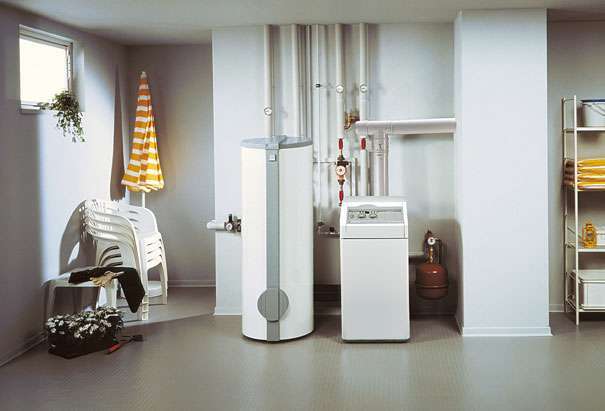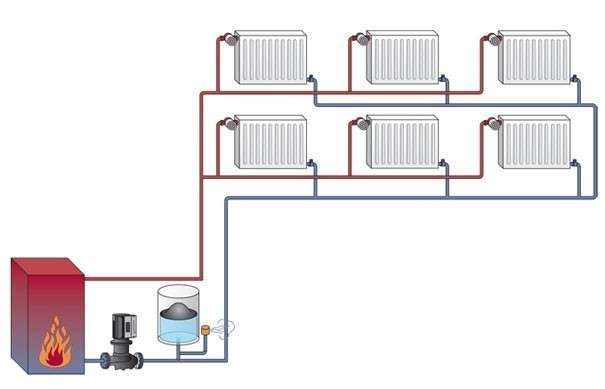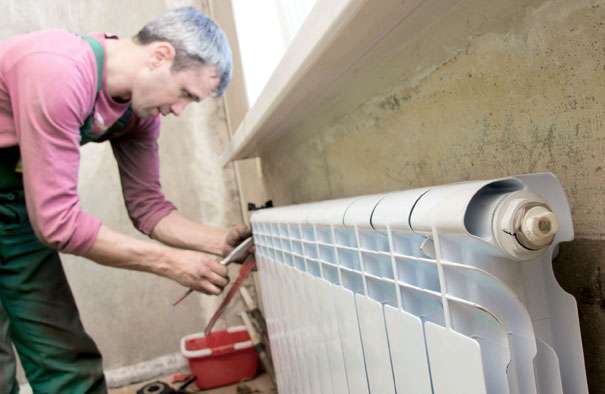Installation of water heating of a private house can be done with your own hands if you have the necessary schemes, materials and tools
There are many residential heating systems, different in the type of heat carrier and energy source used. The most common is hot water heating, which has excellent characteristics and works with various fuel options. Another important advantage is that you can mount water heating of a private house with your own hands, using materials that are accessible and easy to use. As a rule, gas is used as the main type of fuel, but this type of heating works equally well with coal and wood-fired boilers. The system itself remains practically unchanged, only the methods of installing the boilers differ depending on the type of fuel.
Types of water heating of a private house
In practice, two variants of the heating system are most often used: with forced and natural circulation of the coolant. Each of them has certain advantages and requires compliance with a number of technical conditions during installation.

Natural circulation
The system of operation of this system is as follows: heated water moves by gravity in a closed loop through the radiators. This scheme is called a single-tube gravity system and for its correct operation it is necessary to strictly fulfill a number of technical conditions:
- Along the length of the entire heating system, a slope of 2-5 degrees is observed, according to the standard scheme, this is 1 cm per 1 running meter of the pipe.
- At the highest point (usually in the attic), it is necessary to install a special expansion tank with a volume of at least 10% of the total volume of water in the system.
- The gravity system works fine only with pipes of sufficient diameter (at least 1 inch), so steel pipes are used as the main material.
- The riser, coming out directly from the boiler, is installed strictly vertically, avoiding turns and bends.
According to the technical conditions, with a gravitational heating system, the boiler is mounted at the lowest point, and the expansion tank, respectively, at the top. Radiators installed in series are located at the middle level. The main disadvantage of natural circulation is that the radiators farthest from the boiler do not warm up enough, which negatively affects the general microclimate in the house. Also, a large number of welding works significantly complicates the installation of heating (it is desirable that a professional welder works).
Forced circulation
The forced system implies the circulation of the coolant through a special pump, which practically eliminates possible restrictions on the installation of the system and its further operation:
- Modern plastic and metal-plastic pipes with a small diameter are used.
- There are no pipe slope restrictions in the system. Parallel (two-pipe) connection of heating radiators is realized.
- It is possible to almost completely automate the regulation of the temperature of the water in the boiler and, accordingly, the air in the house.
- Heating boiler, both gas and any solid fuel. For solid fuel boilers, a separate room is usually built with good (better forced) ventilation.
- Pipes: usually use metal-plastic, copper, stainless or polypropylene options. But which pipes are better for heating? Steel pipes are practically not used due to complex installation and susceptibility to corrosion. The best option is copper pipes with excellent heat resistance, no rust and a long service life. The only drawback of copper is that it is too expensive compared to other materials. The most popular option is polypropylene and metal-plastic pipes with an optimal price-performance ratio. It is quite simple to mount the heating of a private house with your own hands from polypropylene, the installation process will not cause any particular difficulties even for an inexperienced master. The disadvantages of plastic pipes include susceptibility to water expansion due to temperature and the possibility of damage if improperly installed.
- When choosing pipes for a forced circulation system, it is advisable to discuss various options with professional designers, and develop an emergency power plan for the circulation pump to prevent heating problems.
- The answer to the question of which batteries are best to install also depends on the type of boiler used and the circulation system. Most often they use aluminum, cast iron, steel and bimetallic radiators.
- Heating water tank (boiler). It is installed using a 2-circuit system and is designed to supply the house with hot water.
- An expansion tank and a circulation pump are purchased separately or are included in the standard boiler package. As well as various ball valves, plugs, thermostats and safety valves.
One-pipe and two-pipe hot water heating system
In the process of designing a heating system, one of the schemes is chosen - collector, one-pipe or two-pipe. The most popular and demanded option is a two-pipe system with parallel connection of radiators. With such a system, a variety of connection schemes are used: loop, sectional, star-shaped. This type of wiring provides for the supply of separate pipes to each radiator, which are connected in a manifold. This allows you to effectively regulate the temperature of the coolant and carry out hidden installation of pipes of small diameter.

Do-it-yourself heating installation in a private house
Do-it-yourself preliminary drawing up of a heating installation scheme for a private house with an indication of the location of radiators, a boiler and auxiliary devices is a guarantee of a long and uninterrupted operation of water heating. The scheme is drawn up in compliance with the technical conditions:
- Installation of two or more batteries in one room should be done at the same level.
- The distance between the radiator and the floor is at least 6 cm.
- Radiators are mounted under windows; in corner rooms it is necessary to install an additional battery on a wall adjacent to the street.
The boiler output must be at least 1 kW per 10 sq. m of living room. For a small house, a 25 kW boiler will be enough, while large cottages and estates with an area of over 350 sq. m are equipped with boilers with a capacity of about 50-65 kW. It is advisable to use a water heating system with forced circulation, which allows optimizing fuel consumption, as well as providing increased comfort thanks to automation systems.
Boiler installation
After drawing up a diagram, do-it-yourself heating installation in a private house is done in the following order:
- Installing the boiler on a special concrete base or asbestos block; it is not allowed to install a gas boiler in a basement.
- Connecting the boiler to the chimney. The joint must be covered with clay, which does not collapse under the influence of high temperatures.
- Installation of radiators in regular places (under windows and along walls adjacent to the street). Radiators are easily mounted on special brackets fixed to the wall with dowels.
Installation of radiators
For correct installation, it is necessary to make a preliminary marking of the walls at the same level so that all radiators are in a strictly horizontal position at a distance of 6-7 cm from the floor. This will ensure optimal circulation of the heating medium. The distance from the wall is not less than 2 cm. It is advisable to mount radiators without removing the original packaging. After completing the installation of the heating, a test run is carried out, and only then the packaging is removed.

Installation of pipes and accessories
The final stage of installation is the installation of pipes and additional elements of the system:
- Pipes are connected in various ways, depending on the material from which they are made (brazing, welding, pressure testing).
- The heat pump is mounted on the return flow pipe, taking into account that the water flow must go into the boiler.
- The expansion tank is mounted at the highest point of the system with a ball valve shut off the flow. Approximate height from the boiler is 3 m.
- The water drain, closed by a ball valve, is installed at the lowest point of the system.
- Installation of additional pipes to organize the flow of water bypassing the circulation pump (will ensure the operation of the boiler with a faulty pump).
- Installation of ball valves at the joints of radiators and additional elements for quick dismantling and replacement of equipment during repairs.
- Installation of balancing valves to adjust the hydraulic resistance of the system (mandatory installation if there are two or more risers in the system).
A high-quality self-installed heating system of a private house is subject to mandatory verification in the presence of professional craftsmen. After a successful test run, you can start operating the hot water heating.
What type of hot water heating system do you consider the most efficient? Share your opinion on


